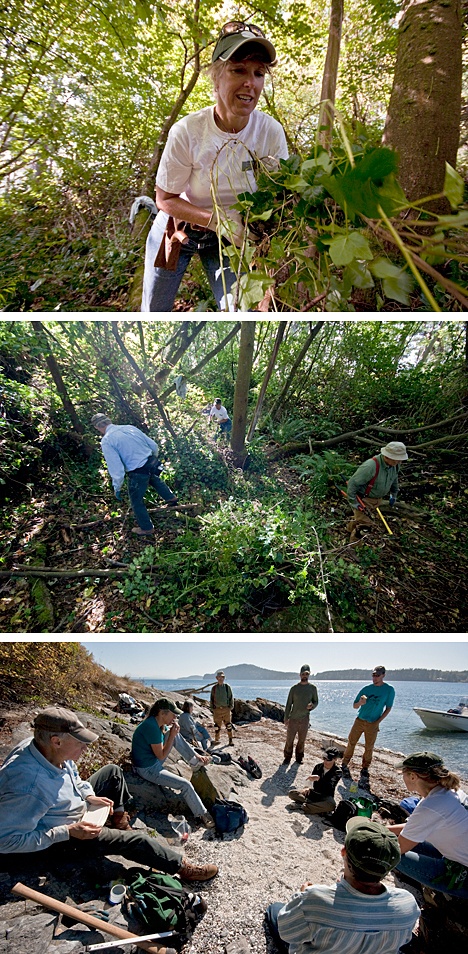By JANE K. FOX
Special to The Journal
The jungle was dense. And alive. Something heavy moved in the undergrowth. There was a thump, the taffeta-like sound of vines ripped from their roots. It was coming closer, and closer. Then came a voice.
“Has anyone seen my sunglasses?”
“Just step backwards, and if you hear the crunch, you’ve found ’em.”
Laughter rose into the air as Diana Stepita scanned the green ground for her glasses. Because, of course, this was not a jungle. It was the woods of Jack Island. And this was not a pack of wild beasts, it was the San Juan Preservation Trust’s work party.
“No glasses,” said Stepita, the membership manager for the trust, “but I did find a sample of beer canum americanus,” she said, holding up an abandoned Rainier Beer can. “Its Latin name,” she joked, and threw it into the trash bag.
Uninhabited Jack Island lies off the northeast stretch of Guemes. With no more than 19 acres of beach and forest, it is not a dominating place. However, in the eyes of the trust, every little bit counts. Which is why, three hours before Stepita lost her sunglasses, two boats carrying four staff members and five volunteers motored to the island’s beach. Their purpose? To clear invasive species, like ivy and English laurel, from choking Jack’s native trees. No parcel of land is too small to merit the trust’s attention.
However, first they had to get ashore. There was no dock, and the leap between the boat and beach was long. Most did not make it with dry feet. Lunch packs, pick axes and sets of clippers were tossed on land and piled high.
“Did you get that at a historical society?” joked one person as a heavy implement was swung onto the beach.
“Hey! We use that,” replied Katie Hover, the trust’s conservation easement steward. “It’s a farm tool,” she added in defense.
Although conversation was lighthearted and laughter frequent, these people meant business. And business meant conservation.
“When people see the beautiful beaches and trees from the ferry, they don’t think about why it’s like that … the reason it is has a lot to do with the trust,” Stepita said.
Dean Dougherty, the trust’s director of stewardship, has an old brochure that displays the dark future Jack narrowly avoided. The picture shows the tiny island, stripped and laden with condos. It adds poignancy to its pristine beach.
The story of how Jack was plucked from such a fate is a testament to the trust’s relationship with the San Juan Islands’ communities. An anonymous buyer bought Jack in the 1970s, saving it from development. The buyer furthered its protection by placing a conservation easement on it. Conservation easements, however, can be broken. Thus to ensure its permanent protection, the buyer donated it to the trust in 2007.
Buying the island was beyond the financial capabilities of the trust, but the trust could offer a unique protection that an easement could not. The land was saved through the combined efforts of ordinary people and the trust. It is this relationship that defines the success of the organization. This is not an institution of scientists, it is a concerned community.
This inclusiveness extends to the volunteers, who laud the opportunity to work on the land they love.
“I know it sounds a little altruistic to say you’re doing it for the environment,” volunteer Rick Machin said as he balanced on a tree branch. “But that’s definitely part of it. You’re creating whole habitats for birds and animals. You can really see what you’ve achieved,” he added, looking at the huge pile of cleared undergrowth.
“Also,” he said, “when else would you get to see these places?”
Volunteer Barbara Schnabel concurred, commenting that it is simply a lot of fun to volunteer for the trust. This is certainly the best opportunity for the public to experience the tiny gem that is Jack.
“We really rely on our volunteers,” Dougherty said, reiterating the importance of the community to the trust’s work.
“With only two land stewards and 43 preserves, we just cant do it all. We’ll take anyone. You don’t have to be a member. Anyone who wants to help.”
To the volunteers on Jack Island, the opportunity to help passes too quickly. The workers slowly leave the wood to have lunch on the sunny beach. Kathleen Foley, the trust’s director of education, produced the “usual volunteer brownies.” For Schnabel, however, the chance to be in the fresh air doing her part has been enough.
“I was ready to get back in the woods,” she sighed, mounting the boat for departure. However, there are plenty of work parties in the future. The trust does not rest on its laurels — English or otherwise. There will always be another jungle to explore, or another pair of sunglasses to lose.
— Jane K. Fox, a graduate of Boston University, is an intern at the San Juan Preservation Trust. She produced this report at the request of The Journal and SanJuanJournal.com



